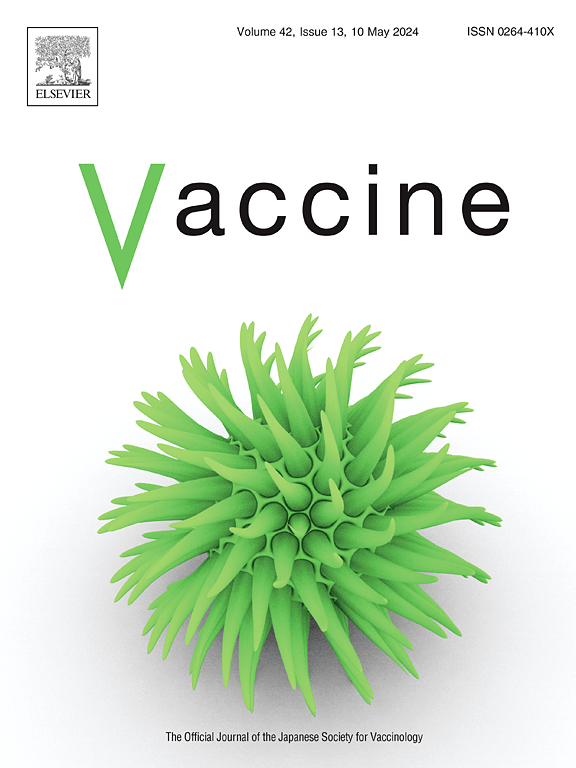蛋源性和细胞源性流感疫苗诱导神经氨酸酶抑制抗体反应的比较。
IF 4.5
3区 医学
Q2 IMMUNOLOGY
引用次数: 0
摘要
神经氨酸酶(NA)特异性抗体有助于免疫流感。虽然研究表明,接种蛋源性灭活流感疫苗(eIIV)后,NA抑制(NAI)抗体滴度增加,但对细胞培养源性(c) IIV的反应尚未报道。方法:在一项临床试验中进行了免疫原性亚研究,比较了2018-2019年和2019-2020年流感季节期间鸡蛋、细胞和重组血凝素(HA)衍生流感疫苗的有效性。在接种前和接种后的血清中测定了疫苗中针对A(H1N1)pdm09和A(H3N2)组分的NAI和中和抗体滴度。结果:在研究的第1年和第2年,对eIIV和cIIV的N1成分的反应是不同的,而对鸡蛋和细胞培养源疫苗的N2成分的反应率和抗体滴度是相似的。例如,43.5%接受eIIV和未接受cIIV的患者在第一年的NAI滴度增加了4倍。两种疫苗对N1和N2的应答之间存在微弱的正相关,而NAI和ha特异性中和抗体应答之间没有相关性。不含NA的重组HA疫苗作为特异性对照;NAI抗体滴度在受体中没有增加,除了两个被认为有亚临床感染的个体。结论:eIIV和cIIV疫苗接种后对NA的抗体反应不同;虽然eIIV对N1和N2组分的应答相似,但cIIV对N1组分的应答比N2组分的应答少。研究确定NA免疫对流感疫苗有效性的影响是有必要的。本文章由计算机程序翻译,如有差异,请以英文原文为准。
Comparison of neuraminidase inhibiting antibody responses elicited by egg- and cell-derived influenza vaccines
Neuraminidase (NA)-specific antibodies contribute to immunity against influenza. While studies have demonstrated increased NA inhibiting (NAI) antibody titers after vaccination with egg-derived inactivated influenza vaccines (eIIV), the response to cell culture-derived (c) IIV has not been reported.
Methods
An immunogenicity sub-study was performed within a clinical trial comparing the effectiveness of egg, cell, and recombinant hemagglutinin (HA)-derived influenza vaccines during the 2018–2019 and 2019–2020 influenza seasons. NAI and neutralizing antibody titers against the A(H1N1)pdm09 and A(H3N2) components of the vaccines were measured in pre- and post-vaccination sera.
Results
Responses to the N1 component of eIIV and cIIV were different in both study years 1 and 2 whereas response rate and antibody titers to the N2 component of egg and cell culture-derived vaccines were similar. For example, 43.5 % of eIIV and no cIIV recipients had four-fold NAI titer increases in year 1. There was a weak positive correlation between responses to N1 and N2 for both vaccine types but no correlation between NAI and HA-specific neutralizing antibody responses. Recombinant HA vaccine that does not contain NA served as a specificity control; NAI antibody titers did not increase in recipients except in two individuals presumed to have subclinical infection.
Conclusion
Antibody responses to NA following vaccination with eIIV and cIIV were not the same; although the responses to the N1 and N2 components of eIIV were similar, there were fewer responders to N1 than N2 of cIIV. Studies to determine the impact of NA immunity on influenza vaccine effectiveness are warranted.
求助全文
通过发布文献求助,成功后即可免费获取论文全文。
去求助
来源期刊

Vaccine
医学-免疫学
CiteScore
8.70
自引率
5.50%
发文量
992
审稿时长
131 days
期刊介绍:
Vaccine is unique in publishing the highest quality science across all disciplines relevant to the field of vaccinology - all original article submissions across basic and clinical research, vaccine manufacturing, history, public policy, behavioral science and ethics, social sciences, safety, and many other related areas are welcomed. The submission categories as given in the Guide for Authors indicate where we receive the most papers. Papers outside these major areas are also welcome and authors are encouraged to contact us with specific questions.
 求助内容:
求助内容: 应助结果提醒方式:
应助结果提醒方式:


